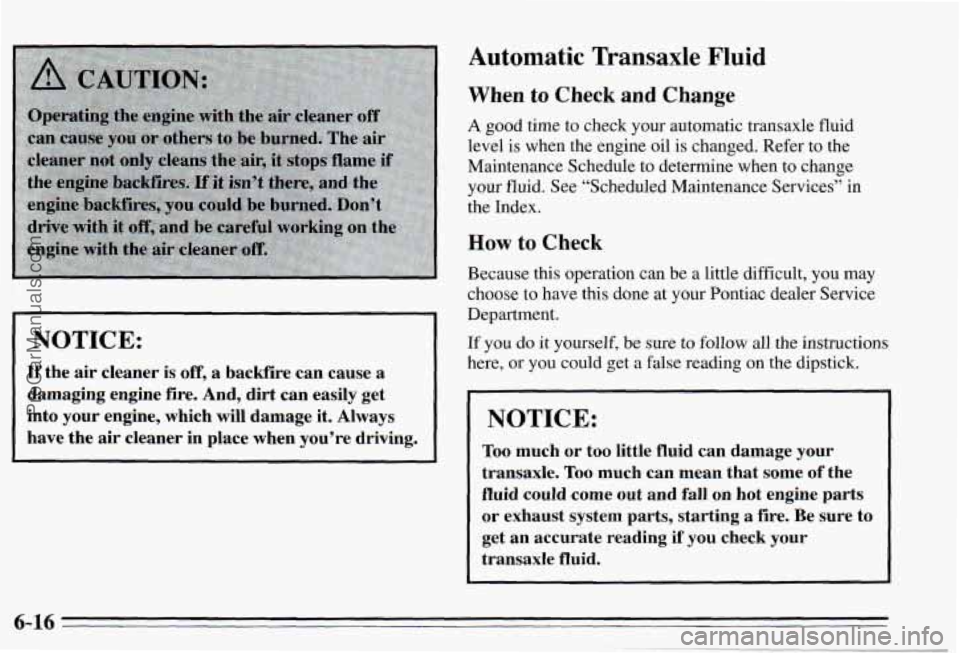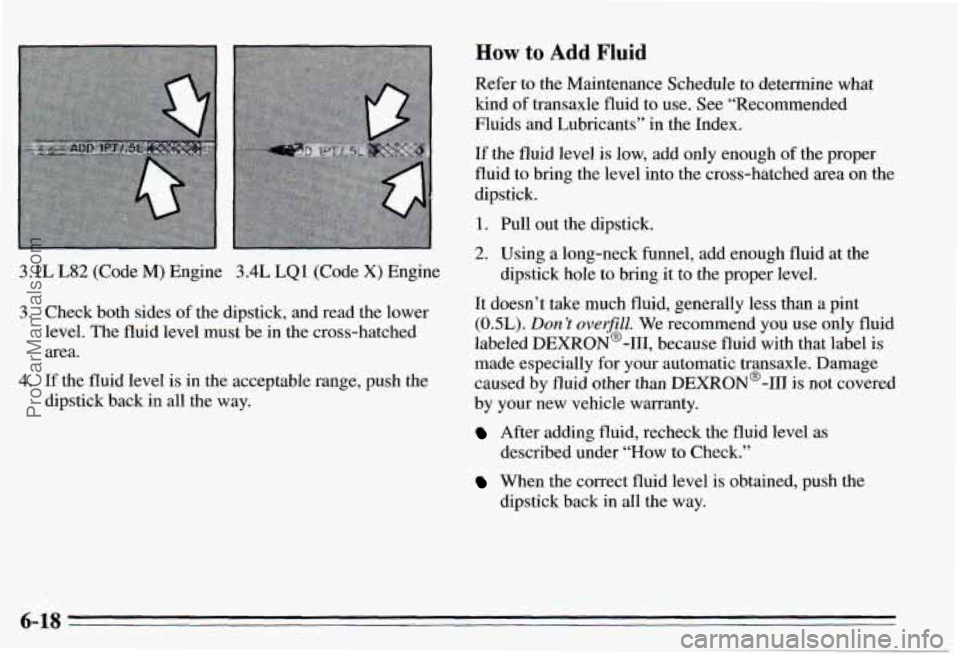Page 2 of 354

1995 Pontiac Grand Prix Owner’s Manual
Seats and Restraint Systems ...... F.-c-.,. ............................................... 1-1
This section tells you how to use your seats and safety belts prop\
erly. It also explains the “SRS” system.
Features and Controls ............................................................... 2-1
This section explains how to start and operate your Pontiac.
Comfort Controls and Audio Systems .................................................. 3-1
This section tells you how to adjust the ventilation and comfort controls and how to operate your
audio system.
YourDrivingandtheRoad ........................................................... 4-1
ProblernsontheRoad ............................................................... 5-1
Here you’ll find helpful information and tips about the road\
and how to drive under different conditions.
This section tells you what to
do if you have a problem while driving, such as a flat tire or engine
overheating, etc.
Here the manual tells you how to keep your Pontiac running properly and looking good.
This section tells you when to perform vehicle maintenance and \
what fluids and lubricants
to use.
This section tells you how to contact Pontiac for assistance and how to get service publications.
It
also gives you information on “Reporting Safety Defects” on pag\
e 8-4.
Here’s an alphabetical listing of almost every subject in this manual. You can use it to quickly find
something you want to read.
Service and Appearance Care.. ....................................................... 6-1
Maintenanceschedule ............................................................... 7-1
Customer Assistance Information ..................................................... 8-1
Index ........................................................................\
..... 9-1
i
ProCarManuals.com
Page 35 of 354

Your vehicle is equipped with a alagnostic module,
which records information about the alia bag system,
The module records Mormation about the readiness
of the system, when the sensors are activated and
driver’s safety belt usage at deployment.
Let only qualified technicians work on your air bag
system. Improper service can mean that your air bag
system won’t work properly. See your dealer for
service.
NOTICE:
If you damage the cover for the driver’s or the
right front passenger’s
air bag, they may not
work properly. You may have to replace the air
bag module in the steering wheel or both the air
bag module and the instrument panel for the
right front passenger’s air bag.
Do not open or
break the
air bag covers.
Sewicing Your Air Bag-Equipped Pontiac
Air bags affect how your Pontiac should be serviced.
There
are parts of the air bag system in several places
around your vehicle. You don’t want the system to
inflate while someone
is working on your vehicle. Your
Pontiac dealer and the 1995 Grand Prix Service Manual
have information about servicing
your vehicle and the
air bag system.
To purchase a service manual, see
“Service Publications’’ in the Index.
The air bag system does not need regular maintenance.
1-28
ProCarManuals.com
Page 179 of 354
When You Are Ready to Leave After
Parking on a Hill
1. Apply your regular brakes and hold the pedal down
while you:
Start your engine;
0 Shift into a gear; and
0 Release the parking brake.
2. Let up on the brake pedal.
3. Drive slowly until the trailer is clear of the chocks.
4. Stop and have someone pick up and store the chocks.
Maintenance When Trailer Towing
Your vehicle will need service more often when you’re
pulling
a trailer. See the Maintenance Schedule for more
on this. Things that are especially important in trailer
operation are automatic transaxle fluid (don’t overfill),
engine oil, belt, cooling system, and brake adjustment.
Each
of these is covered in this manual, and the Index
will help you find them quickly.
If you’re trailering, it’s
a good idea to review these sections before
you start
your trip.
Check periodically to see that all hitch nuts and bolts are
tight.
ProCarManuals.com
Page 215 of 354
Doing Your Own Service Work
If you want to do some of your own service work, you’ll
want to get the proper Pontiac Service Manual. It tells
you much more about how to service your Pontiac than
this manual can. To order the proper service manual, see
“Service Publications” in the Index.
Your vehicle
has an air bag system. Before attempting to
do your own service work, see “Servicing Your Air
Bag-Equipped Pontiac” in the Index.
You should keep a record with all
parts receipts and list
the mileage and the date
of any service work you
perform. See “Maintenance Record”
in the Index.
I NOTICE:
If you try to do your own service work without
knowing enough about it, your vehicle could be
damaged.
6-2
ProCarManuals.com
Page 228 of 354
Air Cleaner
To check or replace the air filter, remove the four screws
and pull
off the cover. Full out the filter.
Be sure
to install the air filter and
install the cover tightly when
you are finished.
Refer to the Maintenance Schedule to determine when to
replace the air filter.
See “Scheduled Maintenance Services” in the Index.
6-15
ProCarManuals.com
Page 229 of 354

~~~ NOTICE:
If the air cleaner is off, a backfire can cause a
damaging
engine fire. And, dirt can easily get
into your engine, which will damage
it. Always
have the
air cleaner in place when you’re driving.
Automatic Transaxle Fluid
When to Check and Change
A good time to check your automatic transaxle fluid
level
is when the engine oil is changed. Refer to the
Maintenance Schedule to determine when to change your fluid. See “Scheduled Maintenance Services” in
the Index.
How to Check
Because this operation can be a little difficult, you may
choose to have this done at your Pontiac dealer Service
Department.
If you do it yourself, be sure to follow all the instructions
here, or you could get a false reading on the dipstick.
NOTICE:
Too much or too little fluid can damage your
transaxle.
Too much can mean that some of the
fluid could
come out and fall on hot engine parts
or exhaust system parts, starting
a fire. Be sure to
get an accurate reading if you check your
transaxle fluid.
6-16
ProCarManuals.com
Page 231 of 354

3.1L L82 (Code M) Engine 3.4L LQ 1 (Code X) Engine
3. Check both sides of the dipstick, and read the lower
level. The fluid level must be in the cross-hatched
area.
4. If the fluid level is in the acceptable range, push the
dipstick back in all the way.
How to Add Fluid
Refer to the Maintenance Schedule to determine what
kind
of transaxle fluid to use. See “Recommended
Fluids and Lubricants”
in the Index.
If the fluid level is low, add only enough of the proper
fluid to bring the level into the cross-hatched area on the
dipstick.
1. Pull out the dipstick.
2. Using a long-neck funnel, add enough fluid at the
dipstick hole to bring it
to the proper level.
It doesn’t take much fluid, generally less than a pint
(OSL). Don’t overfiZ1. We recommend you use only fluid
labeled
DEXRON@-111, because fluid with that label is
made especially for your automatic transaxle. Damage
caused by fluid other than
DEXRON@-III is not covered
by your new vehicle warranty.
After adding fluid, recheck the fluid level as
When the correct fluid level is obtained, push the
described under
“How to Check.”
dipstick back in all the way.
6-18
ProCarManuals.com
Page 236 of 354
A fluid loss in this system could indicate a problem.
Have the system inspected and repaired.
What to Add
Refer to the Maintenance Schedule to determine what
kind
of fluid to use. See “Recommended Fluids and
Lubricants” in the Index.
NOTICE:
When adding power steering fluid or making a
complete fluid change, always use the proper
fluid. Failure to use the proper fluid can cause
leaks and damage hoses and seals.
6-23
ProCarManuals.com